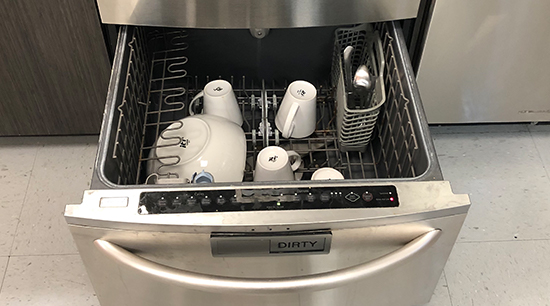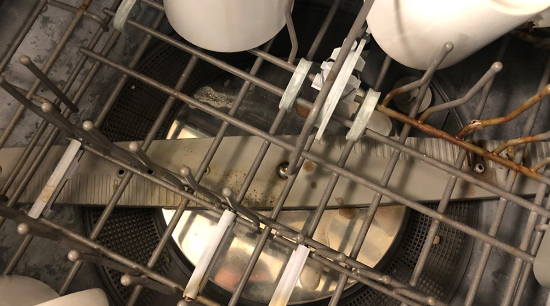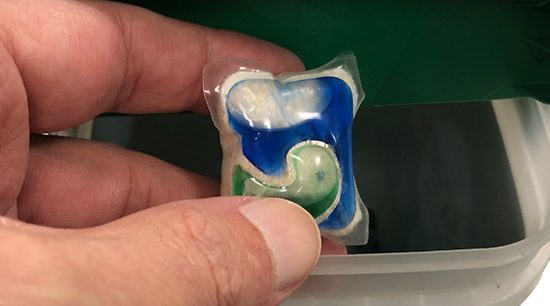Prevent a leaking dishwasher from causing expensive structural damage to your home. Knowing how to handle a leaking dishwasher and keep it functioning properly can prevent unnecessary damages and save you thousands of dollars in repair costs.

alpharettawaterdamageremoval.com assembled the following list of common reasons dishwashers leak and how to fix them before they cause severe damages to your property.
Why Is My Dishwasher Leaking?
Before you begin troubleshooting and poking around the electrical components of your dishwasher, verify that it is unplugged and shut off at the circuit breaker. Also, make sure the water supply valve (found under the kitchen sink) is closed. Then, either consult the user manual that came with your dishwasher or find an online copy of the manual to familiarize yourself with the part(s) of your leaking dishwasher.
The following are some of the most common reasons your dishwasher will leak and what you can do to repair it:
1 – Leaking Dishwasher Door
Is water pooling directly under or dripping from the door? If so, you can safely assume that a leak in the door is the likely cause of your problem. The door latch might be bent, loose, or it may not be latching the way it should.
Solution: Use a screwdriver to tighten the latch and ensure the door’s complete closure. It may be necessary to purchase and install a new latch system.
If water still leaks from the door, you may need to replace the gasket. This is the rubber seal around the door that prevents water from escaping your dishwasher.
Solution: Replace the damaged gasket.
Tip: Soak the new gasket in warm soapy water; this will make it more flexible and easier to manipulate during installation.
Note: This is the perfect time to tighten the door’s hinges and brackets if they’ve come loose.
2 – Loose or Damaged Connections
Connections, valves, and hoses inside your dishwasher can wriggle themselves loose or become inoperative over time.
Solution: Replace cracked, defective, or ill-fitting hoses and valves.
Tip: Ensure that clamps are the correct size and are strong enough to hold their respective hoses in place under pressure.
3 – The Dishwasher’s Tub is Leaking
After years of service, detergents, chemicals, and minerals can wear a hole in your dishwasher’s tub. Whether this is a result of friction or corrosion, a leaking dishwasher tub can quickly cause severe damages.
Solution: Discontinue use of the dishwasher until the tub is repaired, replaced, or the entire unit is replaced.
4 – The Spray Arm Stopped Functioning Properly

The spray arm spins during the wash and rinse cycles, spraying water onto the dishwasher’s contents. However, when the appliance is overcrowded or incorrectly loaded, utensils or dishes may block the arm from properly rotating or cause it to become dislodged or damaged, leading to leaks.
Solution: Install a new spray arm. Find online and order a new spray arm from the manufacturer and replace the malfunctioning one.
First, remove the malfunctioning spray arm by unscrewing it counter-clockwise. Then, line up the center hub of the new piece with the opening on the dishwasher floor and screw it in clockwise. Verify that it spins freely and properly functions before reinserting the bottom dish rack.
5 – The Float Switch Stopped Working
A float assembly consisting of a float and float switch help regulate the internal water level during the wash and rinse cycles. When a dishwasher runs through its cycles, the float lifts with the rising water. When it reaches a certain height, it should trigger the float switch to turn off the water. If this switch malfunctions, the water level can get too high, potentially causing the unit to leak.
Solution: Replace the bad float switch. You might be able to swap out the float switch with a new model on your own, but this is a more complicated repair than the others we’ve addressed.
Take the time to consult your owner’s manual and any instructions included with the replacement part before discarding the old float switch. Secure the new part with screws or clips, firmly reattach the wires to the float assembly, and close the kickplate panel.
Note: If you are not comfortable with the wiring or any part of this installation, hire a qualified repairman.
6 – Using The Wrong Detergent

Regular dish soap foams up too much for your dishwasher to handle and can lead to leaking.
Solution: Only use detergents specifically manufactured for dishwashers.
Tip: Do not use dish soap to pre-rinse your dishes before running them through the dishwasher. Residual soap can bubble up, putting too much pressure on the door seal, causing it to eventually fail and leak.
Note: A leaking dishwasher can dump up to 3 gallons of category 2 water on your floor per use. Older models (pre-1995) can leak more than 20 gallons of water to wreak havoc on your home.
Appliance Malfunctions
In this article, you discovered some of the most common reasons a dishwasher can develop a water leak and how to fix them before causing severe and expensive damages.
Regularly inspect your dishwasher to detect and prevent any developing water problems.
Ignoring your dishwasher leak may result in severe and expensive structural damages to your home. Not to mention the risk of illness from dirty water escaping the dishwasher, and the risk of electrocution that water poses.
Sources:
sears.com/articles/appliances/dishwashers/dishwasher-leaking-fixes.html
a-wash.org/ge_24_in_profile_pdw7800_built_in_dishwasher/q6387996-ge_profile_dishwasher_leaking_from
thespruce.com/dishwasher-repair-guide-4154049
(678) 505-0266